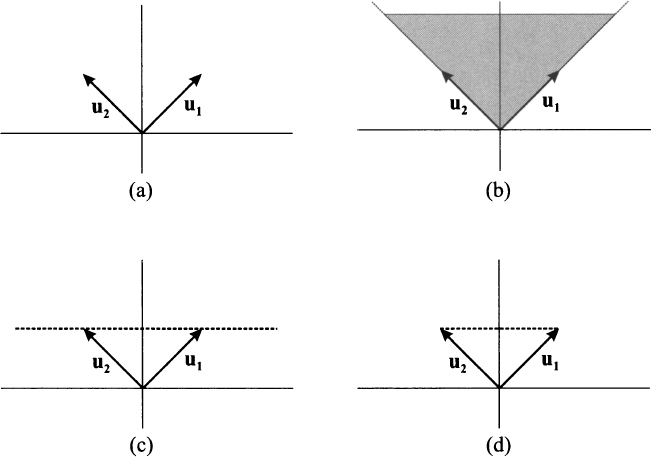The two basic operations on vectors, addition and multiplication by a scalar, can be combined at wish, resulting in a vector; this is called a linear combination of vectors. The linear combination of vectors vj with coefficients αj,

Fig. 3.8 Illustrating linear combinations of vectors.
j = 1, …, m is

If we denote each component i, i = l, …, n, of vector j by vij, the component i of the linear combination above is simply

It is useful to gain some geometric intuition to shed some light on this concept. Consider vectors u1 = [1, 1]T and u2 = [−1, 1]T, depicted in Fig. 3.8(a), and imagine taking linear combinations of them with coefficients α1 and α2

Which set of vectors do we generate when the two coefficients are varied? Here are a few examples:

The reader is strongly urged to draw these vectors to get a feeling for the geometry of linear combinations. On the basis of this intuition, we may try to generalize a bit as follows:
- It is easy to see that if we let α1 and α2 take any possible value in
 , we generate any vector in the plane. Hence, we span all of the two-dimensional space
, we generate any vector in the plane. Hence, we span all of the two-dimensional space  by expressing any vector as a linear combination of u1 and u2.
by expressing any vector as a linear combination of u1 and u2. - If we enforce the additional restriction α1, α2 ≥ 0, we take positive linear combinations. Geometrically, we generate only vectors in the shaded region of Fig. 3.8(b), which is a cone.
- If we require α1 + α2 = 1, we generate vectors on the horizontal dotted line in Fig. 3.8(c). Such a combination is called affine combination. Note that in such a case we may express the linear combination using one coefficient α as αu1 + (1 − α)u2. We get vector u1 when setting α = 1 and vector u2 when setting α = 0.
- If we enforce both of the additional conditions, i.e., if we require that weights be nonnegative and add up to one, we generate only the line segment between u1 and u2. Such a linear combination is said a convex combination and is illustrated in Fig. 3.8(d).14
Leave a Reply